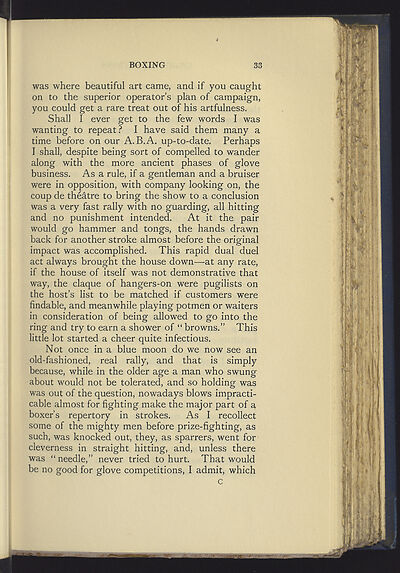Download files
Complete book:
Individual page:
Thumbnail gallery: Grid view | List view

BOXING 33
was where beautiful art came, and if you caught
on to the superior operator's plan of campaign,
you could get a rare treat out of his artfulness.
Shall I ever get to the few words I was
wanting to repeat? I have said them many a
time before on our A. B.A. up-to-date. Perhaps
I shall, despite being sort of compelled to wander
along with the more ancient phases of glove
business. As a rule, if a gentleman and a bruiser
were in opposition, with company looking on, the
coup de theatre to bring the show to a conclusion
was a very fast rally with no guarding, all hitting
and no punishment intended. At it the pair
would go hammer and tongs, the hands drawn
back for another stroke almost before the original
impact was accomplished. This rapid dual duel
act always brought the house down—at any rate,
if the house of itself was not demonstrative that
way, the claque of hangers-on were pugilists on
the host's list to be matched if customers were
findable, and meanwhile playing potmen or waiters
in consideration of being allowed to go into the
ring and try to earn a shower of " browns." This
little lot started a cheer quite infectious.
Not once in a blue moon do we now see an
old-fashioned, real rally, and that is simply
because, while in the older age a man who swung
about would not be tolerated, and so holding was
was out of the question, nowadays blows impracti-
cable almost for fighting make the major part of a
boxer's repertory in strokes. As I recollect
some of the mighty men before prize-fighting, as
such, was knocked out, they, as sparrers, went for
cleverness in straight hitting, and, unless there
was " needle," never tried to hurt. That would
be no good for glove competitions, I admit, which
c
of
was where beautiful art came, and if you caught
on to the superior operator's plan of campaign,
you could get a rare treat out of his artfulness.
Shall I ever get to the few words I was
wanting to repeat? I have said them many a
time before on our A. B.A. up-to-date. Perhaps
I shall, despite being sort of compelled to wander
along with the more ancient phases of glove
business. As a rule, if a gentleman and a bruiser
were in opposition, with company looking on, the
coup de theatre to bring the show to a conclusion
was a very fast rally with no guarding, all hitting
and no punishment intended. At it the pair
would go hammer and tongs, the hands drawn
back for another stroke almost before the original
impact was accomplished. This rapid dual duel
act always brought the house down—at any rate,
if the house of itself was not demonstrative that
way, the claque of hangers-on were pugilists on
the host's list to be matched if customers were
findable, and meanwhile playing potmen or waiters
in consideration of being allowed to go into the
ring and try to earn a shower of " browns." This
little lot started a cheer quite infectious.
Not once in a blue moon do we now see an
old-fashioned, real rally, and that is simply
because, while in the older age a man who swung
about would not be tolerated, and so holding was
was out of the question, nowadays blows impracti-
cable almost for fighting make the major part of a
boxer's repertory in strokes. As I recollect
some of the mighty men before prize-fighting, as
such, was knocked out, they, as sparrers, went for
cleverness in straight hitting, and, unless there
was " needle," never tried to hurt. That would
be no good for glove competitions, I admit, which
c
of
Set display mode to:
![]() Universal Viewer |
Universal Viewer | ![]() Mirador |
Large image | Transcription
Mirador |
Large image | Transcription
Images and transcriptions on this page, including medium image downloads, may be used under the Creative Commons Attribution 4.0 International Licence unless otherwise stated. ![]()
| Sports publications > Sporting notions of present days and past > (45) |
|---|
| Permanent URL | https://digital.nls.uk/231783287 |
|---|
| Description | More than 230 sports publications from the National Library of Scotland's collections. Featured sports include football, rugby, golf, shinty, athletics, bowls, cricket and hockey. Among the material from the late 19th and early 20th centuries are match programmes, club histories, and handbooks. From the late 20th century are promotional materials to encourage greater diversity in sport. Most items cover sports activities in Scotland. There are also publications relating to the Olympics and international matches. |
|---|---|
| Additional NLS resources: |
|

